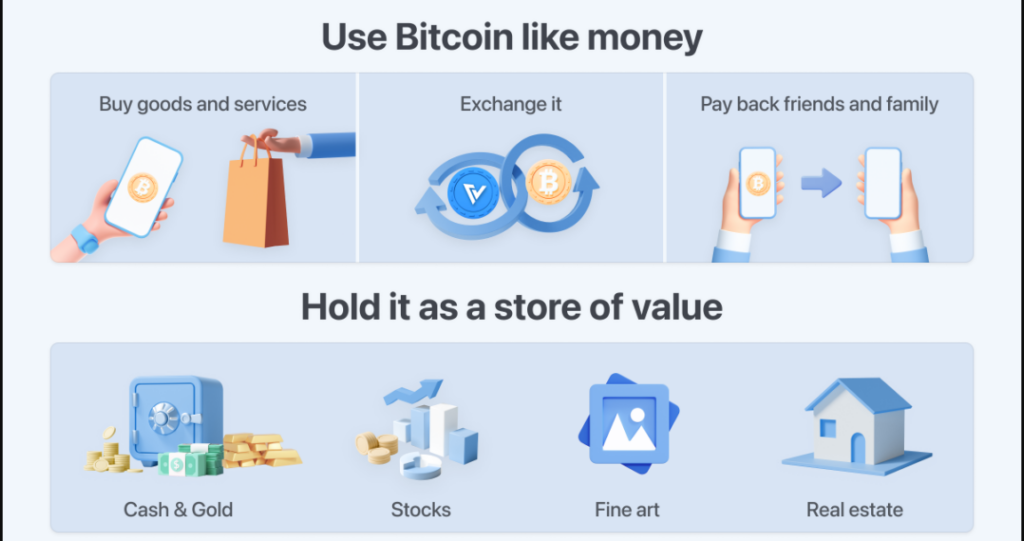Bitcoin, often hailed as digital gold, has garnered global attention for its innovative blockchain technology. At its core, Bitcoin operates on a decentralized network powered by its Layer 1 blockchain. In this article, we’ll explore Bitcoin’s Layer 1 blockchain in simple terms, unraveling its complexities to provide a clear understanding.
What is Bitcoin?
Bitcoin is a digital currency created by an anonymous person or group of people using the pseudonym Satoshi Nakamoto in 2008. It operates on a decentralized network, meaning it is not controlled by any single entity like a government or financial institution. Instead, it relies on a technology called blockchain to record transactions and maintain the integrity of the system.

Understanding Layer 1 Blockchain
Layer 1 blockchain refers to the foundational layer of a blockchain network. It is the underlying infrastructure that supports the entire system.
Layer 1 blockchain is like the solid ground beneath a building—it’s the base that holds everything up. In a blockchain network, Layer 1 is the foundation, the very first layer where all the important stuff happens. It’s the backbone of the whole system, supporting everything above it.
Think of Layer 1 as the groundwork that allows the network to function smoothly. Just like how a house needs a strong foundation to stay standing, a blockchain network needs Layer 1 to operate properly. Without it, everything would fall apart.
Layer 1 handles all the essential tasks, like processing transactions and making sure they’re secure. It’s responsible for keeping track of who owns what and preventing anyone from cheating or tampering with the records. In other words, Layer 1 is the heart of the blockchain network, keeping everything running smoothly and securely.
What is Bitcoin’s Layer 1 Blockchain?
Bitcoin’s Layer 1 blockchain serves as the foundational layer of its network. It forms the backbone of the entire system, facilitating the recording of transactions, maintaining security, and ensuring decentralization. Understanding the key components of Bitcoin’s Layer 1 blockchain is crucial to grasp its functionality.

Key Components of Bitcoin’s Layer 1 Blockchain
- Blocks: Transactions on the Bitcoin network are grouped together into blocks. Each block contains a set of transactions along with other important information, such as a timestamp and a reference to the previous block.
- Proof of Work (PoW): Bitcoin uses a consensus mechanism called Proof of Work to validate transactions and secure the network. Miners compete to solve complex mathematical puzzles, with the first one to find the solution being rewarded with newly minted bitcoins and transaction fees.
Bitcoin’s Proof of Work (PoW) is a pivotal aspect of its blockchain protocol, ensuring the integrity and security of the network. PoW involves miners competing to solve complex mathematical puzzles in order to validate and add new blocks to the blockchain. These puzzles require substantial computational power to solve, making it difficult for any single entity to manipulate the network.
Bitcoin Miners
Miners invest significant resources, including electricity and specialized hardware, to participate in the PoW process. Once a miner successfully solves a puzzle, they broadcast their solution to the network, and if other nodes verify it, they add the new block to the blockchain.
Miners are rewarded with newly minted bitcoins and transaction fees for their efforts. PoW not only incentivizes miners to maintain the network but also acts as a consensus mechanism, ensuring agreement on the state of the blockchain across the decentralized network.
Despite criticisms regarding its energy consumption, PoW remains a fundamental component of Bitcoin’s security model, underpinning its decentralization and trustlessness.
- Decentralization: One of the core principles of Bitcoin is decentralization. A distributed network of nodes maintains it, with each node contributing to the overall security and resilience of the system.
Bitcoin decentralization means that no single person, company, or government controls it. Instead, it’s like a big team effort. Imagine a giant puzzle requiring solving, and every participant in the Bitcoin network collaborates to solve it. This puzzle-solving process, known as mining, involves individuals using computers to verify transactions and append them to the blockchain, which resembles a large ledger recording all Bitcoin transactions.
Because there are so many people involved in this process, it’s very hard for anyone to cheat or manipulate the system. It’s like having many referees watching a game to make sure everything is fair.
Free From Control
Decentralization also means that Bitcoin isn’t tied to any one country or organization. It’s a global currency that anyone can use, no matter where they are in the world. This is important because it means that no single government or bank can control or influence Bitcoin.
Another way to think about decentralization is like a big network of friends. Each person in the network looks out for each other and makes sure everything is running smoothly. If one person tries to do something shady, the rest of the network will notice and stop them.
Overall, Bitcoin’s decentralization is what makes it unique and valuable. It’s a system built on trust, collaboration, and transparency, where everyone has a role to play in keeping it secure and reliable.
- Cryptography: Cryptography plays a crucial role in securing the Bitcoin network. It is used to create digital signatures that verify the authenticity of transactions and ensure that only the rightful owner of a bitcoin can spend it.
Bitcoin cryptography forms the backbone of its security and functionality, ensuring the authenticity, integrity, and privacy of transactions on its network. At its core, Bitcoin utilizes various cryptographic techniques to achieve these objectives.
One of the fundamental cryptographic elements of Bitcoin is the public-private key pair system. Each user on the network holds a unique pair of cryptographic keys: a public key, functioning as their address and shared with others for receiving bitcoins, and a private key, kept secret and used to sign transactions for spending bitcoins.
Bitcoin Blockchain’s Asymmetric Cryptography
The use of asymmetric cryptography in generating these key pairs ensures that while anyone can verify transactions using the public key, only the holder of the corresponding private key can authorize transactions.
Another crucial cryptographic component is the digital signature. When a user initiates a transaction, they create a digital signature using their private key, which serves as proof of ownership and authorization. Other network participants verify this signature using the sender’s public key, ensuring the transaction’s legitimacy and integrity remain intact.
Furthermore, Bitcoin employs cryptographic hash functions extensively throughout its protocol. Hash functions are used to create unique identifiers for transactions and blocks, linking them together in a tamper-evident manner. Additionally, Merkle trees, constructed using hash functions, enable efficient verification of transactions within blocks.
Bitcoin’s cryptography plays a vital role in securing the network, facilitating trustless transactions, and ensuring the immutability of its blockchain ledger.

How Transactions Work on Bitcoin’s Layer 1 Blockchain
When you send bitcoins to someone else, a transaction is created and broadcasted to the Bitcoin network. Miners then collect these transactions and include them in the next block they mine. Once a transaction is included in a block and added to the blockchain, it is considered confirmed and irreversible.
Each transaction has inputs and outputs. Inputs denote the bitcoins being spent, while outputs signify where the bitcoins are being sent. To prevent double spending, Bitcoin uses a system of digital signatures and a public ledger that records all transactions.
Bitcoin Blockchain Security and Immutability
One of the key features of Bitcoin’s Layer 1 blockchain is its security and immutability. Once the network confirms and adds a transaction to the blockchain, altering or reversing it becomes practically impossible. This is due to the decentralized nature of the network and the cryptographic techniques used to secure it.
Bitcoin’s security and immutability are foundational to its appeal and functionality. Utilizing a decentralized network and robust cryptographic methods, Bitcoin ensures that transactions are secure and resistant to tampering.
After the network confirms and adds transactions to the blockchain, altering them becomes extremely challenging due to the network’s distributed nature and consensus mechanisms like Proof of Work. This high level of security fosters trust and transparency within the system, as transactions can be verified by anyone with access to the blockchain.
Overall, Bitcoin’s security measures and immutability not only provide a reliable platform for financial transactions but also pave the way for innovative applications across various industries.
Potential Limitations of Bitcoin’s Layer 1 Blockchain
While Bitcoin’s Layer 1 blockchain has proven to be robust and secure, it is not without its limitations. One of the most notable limitations is scalability. Because of block limits and a low number of transactions per block, which miners only mine once a minute, the Bitcoin blockchain encounters scalability issues. Many people have proposed solutions, such as the introduction of the Lightning Network.
Another limitation is energy consumption. Bitcoin mining requires a significant amount of computational power, which in turn consumes a large amount of energy. This has led to concerns about the environmental impact of Bitcoin and calls for more sustainable mining practices.

Future Developments and Innovations For Bitcoin Blockchain
Despite its limitations, Bitcoin continues to evolve and adapt. Developers are working on solutions to improve scalability and reduce energy consumption, such as the Lightning Network and more energy-efficient mining algorithms.
You May Also Like: The Ethereum Blockchain
Final Thoughts
Bitcoin’s Layer 1 blockchain is a groundbreaking technology that has revolutionized the way we think about money and finance. By providing a decentralized and secure platform for peer-to-peer transactions, it has paved the way for a new era of digital currency. As the technology continues to evolve, it will be exciting to see how Bitcoin and other blockchain projects shape the future of finance and technology.
